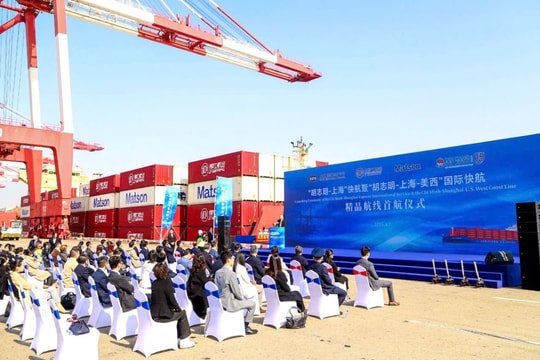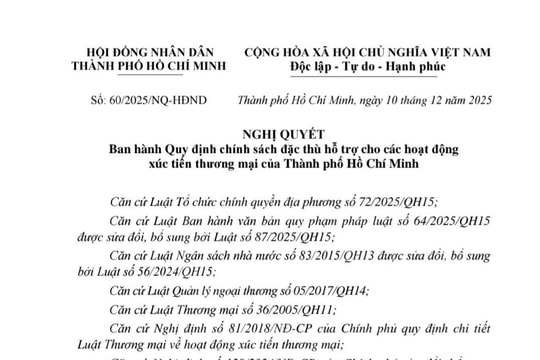
This comes at a time when trade relations between the two countries have been strengthened by several bilateral agreements and recent high-level visits. The new move by the U.S. has sparked widespread concern over Vietnam's competitiveness, its ability to maintain market share, and how its businesses can adapt in the coming period.
The Tariff Decision and a New Political–Trade Landscape
On April 2, 2025, U.S. President Donald Trump announced a blanket minimum tariff of 10% on all imports and nearly 60% on Chinese goods. The escalating tit-for-tat rhetoric between the U.S. and China continues to intensify an already tense and unpredictable situation. Notably, Vietnam has been placed on the list of countries "causing trade imbalances with the U.S.," with a proposed tariff of up to 46%. According to Reuters, the Trump administration justifies this by citing Vietnam's growing trade surplus with the U.S., and accusing the country of "not importing enough U.S. goods to balance the trade account."
This announcement came as a shock to many Vietnamese exporters, especially those in key sectors with large shipments to the U.S., such as textiles, footwear, furniture, electronics, and agriculture. The new tariff would raise the price of Vietnamese goods in the U.S. market, reducing their competitiveness compared to products from countries like Mexico, Bangladesh, or India.
The political context also plays a key role in this development. The “America First” policy made a strong return during Trump’s 2024 campaign, accompanied by a wave of calls for tighter control over foreign goods to protect domestic manufacturing. Thus, “trade punishment” targeting countries with large surpluses with the U.S. has become a preferred policy tool.
Direct Impact on Vietnam’s Key Export Sectors
According to data from Vietnam’s General Department of Customs, the United States has been Vietnam’s largest export market for many consecutive years, accounting for about 30% of the country’s total export turnover. In 2024, Vietnam’s exports to the U.S. exceeded $110 billion, with major contributors being textiles ($18 billion), wood products ($11 billion), footwear ($9 billion), electronics (over $25 billion), and seafood.
A 46% tariff could cause many Vietnamese firms to lose orders, reduce production scales, or even cease operations. Small and medium-sized enterprises (SMEs), in particular, which have limited ability to shift to other markets, would suffer the most.

“If this tariff is applied, Vietnamese garments will no longer be competitive in the U.S. market. American consumers have many cheaper alternatives from countries not subject to high tariffs,” - Mr. Pham Xuan Hong, Chairman of the Ho Chi Minh City Association of Garment, Textile, Embroidery, and Knitting.

In the wood sector, despite having built a reputation for “legally sourced products,” many firms still rely on imported raw materials, making it difficult to cut costs in the short term. A representative from the Vietnam Timber and Forest Products Association (VIFOREST) described this as a “policy shock” that requires timely adjustment.

Meanwhile, the electronics sector — with its complex value chain and dependence on foreign direct investment (FDI) — could be indirectly impacted if multinational corporations consider relocating production from Vietnam to avoid U.S. tariffs.
Response from the Vietnamese Government and Businesses
Immediately after the announcement of the 46% tariff, the Vietnamese government took diplomatic steps to mitigate its effects. Vietnam proposed a 45-day delay in the tariff implementation and pledged to purchase more goods from the U.S. to help reduce the trade surplus.
Furthermore, organizations such as AmCham Vietnam and the Vietnam Chamber of Commerce and Industry (VCCI) jointly submitted letters to the U.S. Trade Representative (USTR) and Congress, requesting a pause and reconsideration of the tariffs. They argued that the move lacked economic justification and risked damaging a bilateral relationship that had been positively developing.
Vietnamese enterprises are also stepping up efforts to find alternative markets and boost exports to the EU, Japan, and ASEAN through free trade agreements such as the EVFTA and RCEP. At the same time, there is a growing focus on producing higher value-added products, verifying product origin, and ensuring supply chain transparency — strategies being adopted by an increasing number of businesses.
Many experts have warned that in the context of a slowing globalization trend and nations prioritizing their own interests, Vietnam must adopt long-term strategies rather than short-term reactions. These include restructuring exports, deepening trade negotiations, and building a national image as a "transparent and trustworthy partner."
The threat of high tariffs from the United States serves as a stark reminder that international trade is not just about economics — it is inextricably linked to geopolitics and negotiation power. For Vietnam, a country with a high degree of trade openness and strong reliance on exports, particularly to the U.S., such fluctuations always carry inherent risks.
This is not the first time Vietnam has faced tough trade measures from major partners. However, without timely adjustments in export structure, enhancements in technological value, market diversification, and proactive engagement in major global trade frameworks, losing market share is only a matter of time.
Amid increasingly unpredictable geopolitical dynamics, Vietnam needs to skillfully integrate trade diplomacy, domestic policy reforms, and the internal strength of its business community to protect national interests in global trade. This is not merely an urgent requirement — it is a survival imperative to maintain Vietnam’s standing on the global economic map.









.jpg)
.png)
.png)
.png)


.png)
.png)






.png)

